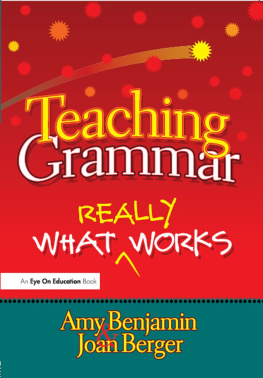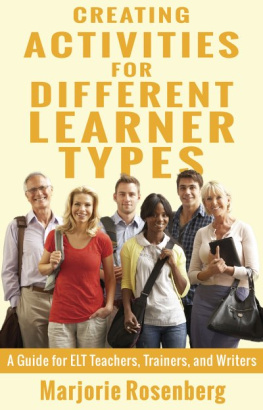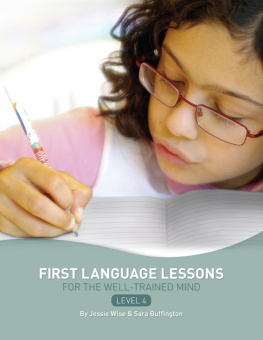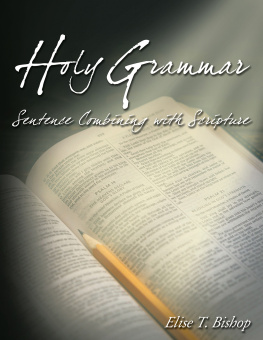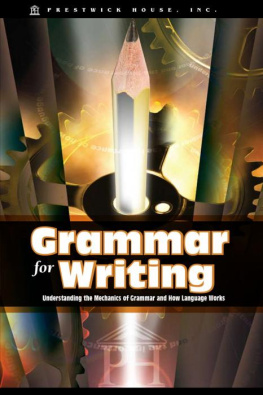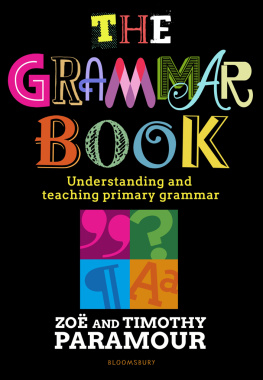
First published 2010 by Eye On Education
Published 2013 by Routledge
711 Third Avenue, New York, NY 10017, USA
2 Park Square, Milton Park, Abingdon, Oxon OX14 4RN
Routledge is an imprint of the Taylor & Francis Group, an informa business
Copyright 2010 Taylor & Francis
All rights reserved. No part of this book may be reprinted or reproduced or utilised in any form or by any electronic, mechanical, or other means, now known or hereafter invented, including photocopying and recording, or in any information storage or retrieval system, without permission in writing from the publishers.
Notices
No responsibility is assumed by the publisher for any injury and/or damage to persons or property as a matter of products liability, negligence or otherwise, or from any use of operation of any methods, products, instructions or ideas contained in the material herein.
Practitioners and researchers must always rely on their own experience and knowledge in evaluating and using any information, methods, compounds, or experiments described herein. In using such information or methods they should be mindful of their own safety and the safety of others, including parties for whom they have a professional responsibility.
Product or corporate names may be trademarks or registered trademarks, and are used only for identification and explanation without intent to infringe.
Library of Congress Cataloging-in-Publication Data
Benjamin, Amy
Teaching grammar : what really works / Amy Benjamin, Joan Berger.
p. cm.
ISBN 978-1-59667-138-6
1. English languageGrammarStudy and teaching (Elementary)
I. Berger, Joan. II. Title.
LB1576.B438 2009
372.61dc22
2009043778
ISBN: 978-1-596-67138-6 (pbk)
ISBN: 978-1-317-92680-1 (ePub)
Vocabulary at the Center
Amy Benjamin and John T. Crow
Formative Assessment for English Language Arts:
A Guide for Middle and High School Teachers
Amy Benjamin
But Im Not A Reading Teacher:
Strategies for Literacy Instruction in the Content Areas
Amy Benjamin
Empowering Students to Write and Re-Write
Warren E. Combs
Successful Student Writing Through Formative Assessment
Harry Grover Tuttle
Motivating Every Student in Literacy
(Including the Highly Unmotivated!) Grades 3-6
Sandra K. Athans and Denise Ashe Devine
Literacy from A to Z:
Engaging Students in Reading, Writing, Speaking and Listening
Barbara R. Blackburn
Writing put to the Test: Teaching for the High Stakes Essay
Amy Benjamin
Writing in the Content Areas, 2nd Edition
Amy Benjamin
English Teachers Guide to Performance Tasks and Rubrics: Middle School
Amy Benjamin
English Teachers Guide to Performance Tasks and Rubrics: High School
Amy Benjamin
Active Literacy Across the Curriculum
Heidi Hayes Jacobs
50 Ways to Improve Student Behavior:
Simple Solutions to Complex Challenges
Annette Breaux and Todd Whitaker
To Mitchell, my favorite student
(even if Im not his favorite teacher).
Amy Benjamin
To all my children, from whom I continue to learn.
Joan Berger
Amy Benjamin is a literacy consultant who works with educators across the United States and Canada. Her work is informed by more than thirty years of teaching experience at the middle and high school levels. She has been recognized for excellence in teaching by the New York State English Council, the State Education Department of New York, Tufts University, and Union College.
As a member of the professional development team for the National Council of Teachers of English (NCTE), and president of its Assembly for the Teaching of English Grammar, Amy has had a major impact in transforming the paradigm of grammar instruction from fill-in-the-blank worksheets to the kind of active, authentic, discovery-based models presented in this book. This is Amys eleventh book for Eye on Education.
Joan Berger has developed unique approaches for teaching writing and grammar during her four decades working with high-school and middle-school students. A Golden Apple finalist, Joan has written articles for various National Council of Teachers of English journals, as well as NCTEs teacher sourcebook Professional Communities at Work: Grammar. Now a consultant who works with schools and school districts, Joan also speaks frequently at NCTE conferences about writing and grammar. At her workshops, Joan gives teachers fun, easy-to-use strategies that inspire their students to write effectively.
Many of the tools discussed and displayed in this book are also available on the Routledge website as Adobe Acrobat files. Permission has been granted to purchasers of this book to download these tools and print them.
You can access these downloads by visiting
www.routledge.com/9781596671386 and click on the Free Downloads tab.
Figure
We believe its possible to teach grammar using contemporary methods that result in durable learning. Such methods are engaging, lively, and social. They include teaching through visuals and hands-on manipulatives, rhythm, creative dramatics, inductive reasoning, problem-solving, wordplay, and pattern-finding. We present our ideas in this book as a way of seeing grammar with new eyes. We begin with a look at traditional ways of viewing grammar instructionor, as we believe, seeing grammar with old eyesand then look at some new possibilities.
What Do Teachers Say about Teaching Grammar?
We begin our workshops by asking teachers to share what comes to mind when they hear the words teaching grammar. What we hear is mostly negative.
We hear that teaching grammar is frustrating. It doesnt work. Students seem to need the same lessons over and over. Not only do they forget the grammar that they do learn in school, but they fail to put it to use to create better language, either in writing or in speech. Lets clarify right here that what we mean by better language is language that is well-suited to the audience and purpose. Assessments that measure whether students can pick out certain parts of speech or circle the correct choice of singular or plural verb in a premade sentence dont say much about what happens, grammatically speaking, in the real world of the students language. That real world consists of various audiences for various purposes, informal as well as formal, reflective of the ever-changing nature of all languages. When the grammar that comes from the grammar book differs from the grammar of real communication, practice in the former does not result in application to the latter. And scarce resources of classroom time get squandered in the effort.
We hear that grammar instruction cant be anything but drill, drill, drill. Its boring. We can liven it up with gimmicks like grammar bees, contests, rewards, and mnemonics, but in the end its about memorizing rules and deferring to the answer key. According to tradition, critical thinking does not play a part in grammar instruction. Teachers and the general public usually believe that answers to grammatical problems are, like math, either right or wrong in all circumstances.
We hear exasperated teachers complaining that the burden of teaching the basics of grammar shouldnt be at their level. Students should have been taught grammar in the lower grades. In educational circles, this is called the blame-down. We see it all the time in a spiral of expectations about what students should know and be able to do at given levels. The blame-down is unproductive thinking for teachers under any circumstances, but especially for grammar. Old-fashioned grammar instruction is not going to work very well for most students, no matter how often, or how loudly, it is taught. What teachers need to do, as we show in this book, is find a new way, not a way to introduce ineffective practices earlier.
Next page
